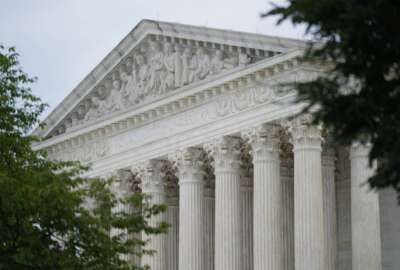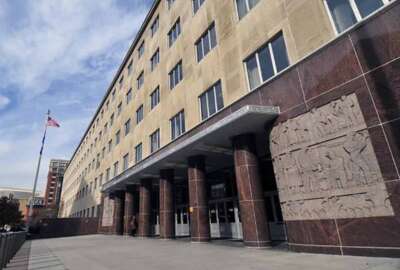
Hubbard Radio Washington DC, LLC. All rights reserved. This website is not intended for users located within the European Economic Area.
Hubbard Radio Washington DC, LLC. All rights reserved. This website is not intended for users located within the European Economic Area.
The Administrative Office of the U.S. Courts keeps the busy system of court dockets running. It has information technology underpinning this work. The Governmen...
The Administrative Office of the U.S. Courts keeps the busy system of court dockets running. It has information technology underpinning this work. The Government Accountability Office said the Court lacks a strategic approach to improving its IT staff. For more, the Federal Drive with Tom Temin spoke with GAO’s Director of Information Technology Acquisition Management, Carol Harris.
Interview transcript:
Tom Temin And I have to ask you, is this the first time the GAO has looked at the court system, the judiciary branch? I don’t recall another report on this.
Carol Harris Yeah, it’s not the first time we’ve done work within the judiciary branch, but it certainly is the first that we’ve done taking a look at I.T. management within the judiciary branch.
Tom Temin And the Administrative Office of the Courts, then, it’s not a court, but it is the underpinning enabling organization for the courts throughout the country.
Carol Harris That’s right. So they serve as the central organization within the federal courts to provide I.T. services. Which is why we focused on the administrative office.
Tom Temin And I think the first time anyone ever saw a computer in a courtroom was the O.J. Simpson trial with Judge Ito and his laptop there. And at this point, the courts are pretty rich in IT, fair to say? I mean, they have a pretty good base there.
Carol Harris Oh, yes. They’ve come a long way since then.
Tom Temin How many people work in IT for the court system?
Carol Harris Right now, it’s about 420 staff as of March 2022, and that comprises about one third of AO’s total staff.
Tom Temin So that’s a big percentage.
Carol Harris Yeah, that’s a huge percentage. For organizations that size, we would expect to see somewhere between like 160 to maybe 200 folks. So about half of that.
Tom Temin So when you point that out to the Judiciary Committee and Congress, the committees, they’re going to probably question you on that one also.
Carol Harris Most likely. But I think it speaks to the inefficiencies of how IT is managed within the judiciary branch and why, again, it’s so important to have that [chief information officer] in place to be able to identify those efficiencies that can cut across those departments.
Tom Temin I mean, what is the major function of IT, case management?
Carol Harris So within the administrative office, they’re broken down into three departments. And what’s interesting, while they are the IT providers for the federal courts, their management of IT and their IT workforce is actually very highly decentralized. So within these three departments, they operate almost like autonomous shops where they have their own IT, they manage their own IT. So within their administrative services, they’re the ones that are providing the IT systems that support their budgeting, accounting, HR, procurement functions, sort of like the commodity IT. And then they’ve got program services, to your point, that manage the judiciary’s case management systems. They provide the support to the federal judges, clerks, the federal defenders and so forth. And then the technology services department, which manages the infrastructure.
Tom Temin And this decentralized nature, is it analogous to the way Congress, a lot of that work is decentralized because each member is kind of like its own little small business, even though there’s a major -would that be a good analogy?
Carol Harris Yeah, I think that’s fair to say.
Tom Temin And let’s talk more about the workforce. You found that they don’t really follow the major good practices that you have previously identified for workforce management.
Carol Harris That’s right. So we focused on their IT workforce in particular, because this was our first foray into their IT management. And what we found, we focused on strategic planning, on recruitment and hiring, training, development and performance management. And what we found was that within recruitment and hiring and training and development in particular, AO still has quite a long ways to go. While they identified, for example, that like cybersecurity skills gaps, that’s present there — they requested in fact $75 million for cyber related salaries and expenses for Fy22, which was about a 33% increase over the prior year — well, they didn’t report to management its progress in addressing those cyber skill gaps in their IT workforce. And in fact, they lacked metrics for monitoring how effective its recruiting and hiring efforts were at addressing those skill gaps. And so that was an issue. And also as far as training and development, they had yet to perform any formal assessments of their staff IT training. So there is no way to tell if the courses were actually contributing to improved performance and results. But on the bright side though, in terms of performance management, AO did substantially implement that area where they had mechanisms in place to provide regular performance feedback to their staff.
Tom Temin All right. So a couple of questions. And by the way, we’re speaking with Carol Harris. She’s director of information Technology Acquisition Management at the GAO. My first question gets back to cybersecurity, and that is that must be a really big issue because in addition to the integrity of the court system itself, so much evidence nowadays that is held by the courts as part of trials is electronic evidence, things gained from people’s computers and logs and so forth. So I imagine a little bit of inattention to cyber could really affect court cases ultimately.
Carol Harris Absolutely. Which is why when we looked at the IT workforce, it’s so important for them to identify those skills gaps and have comprehensive plans as to whether they have right sized their staffing for the mission that they serve. And certainly with cybersecurity, it’s great that they did identify that they had skills gaps. But it’s very important to have those metrics in place to ensure that they are effectively closing it, especially because of the sensitivity of the information that they hold. They want to make sure they have solid people there to adequately protect their systems.
Tom Temin And when I look at the major IT workforce areas and I see that performance management, as you mentioned, is substantially implemented, but training and development, recruitment and hiring and strategic planning are only minimally or partially implemented. That means they’re great with people once they get them, but they’re not very good at the feedstock level.
Carol Harris Yeah. So the feedback that they’re providing their staff, it’s pretty robust, but certainly the training and development when they’re there, they need to do a better job there to ensure that their folks are properly trained. And then also providing those metrics to ensure that the training that they are providing is actually serving the mission.
Tom Temin And on recruitment and hiring with minimally implemented best practices there. That’s kind of something they share with the administrative or the executive branch of government, and that is the whole outreach, recruitment, retention, hiring is a challenge. And I wonder if that could be because they’re not working that hard at it, because they certainly have a compelling mission as much as any executive branch agency. Or do you think maybe it’s because people look at the courts and see chaos nowadays just because of how long it takes to schedule things? And there’s been some not so great court publicity lately?
Carol Harris Well, they certainly have a compelling mission. I think the primary root cause that we’ve identified is that AO lacks a CIO who is responsible for the recruitment and the hiring of their IT workforce and managing that IT workforce. And that actually goes to our final finding within the report, which really speaks to why they don’t have a robust foundation in their IT workforce planning, as well as their IT project management. And it’s because they don’t have a single person that’s accountable for the performance of the IT investments that cut across the enterprise.
Tom Temin And by the way, the head of the administrative office of the U.S. Courts, who does that person report to?
Carol Harris That’s the director. The director reports to the Judicial committee. And they are a group of federal judges that are responsible for making decisions about IT, policy for the entire court system. So he reports to that committee.
Tom Temin And that committee changes composition periodically.
Carol Harris That’s my understanding, yes.
Tom Temin Well, that’s a whole other area of study one of these days to see how the courts, who runs that whole thing. It seems to be a self-sustaining amoeba-like mechanism. And now you have made a really long list of recommendations here. I don’t recall too many reports that have 18. What are they basically driving at?
Carol Harris So the 18 recommendations really identified improvements for addressing the gaps that we identified relative to the IT workforce, as well as in IT project management. What we did was we looked at the three largest IT projects within the administrative office, and we found that for the most part, they’re doing a pretty good job in complying with supplier agreement management best practices, but they only partially implemented the majority of project management best practices related to, for example, cost estimating and schedule management. We did find that their cost estimates were not comprehensive and their schedules were just not well constructed. So we provided recommendations relative to those particular areas. But the most important one in my mind relates to the CIO and making a recommendation that they hire a CIO who is responsible for all of the IT within their organization.
Tom Temin And does the Judiciary Committee here that runs this, and with the CIO and the director of the administrative, where do they live? Are they like in the Supreme Court building or where does this whole apparatus physically live?
Carol Harris The AO is outside of the Judicial Committee. And so, again, they report to the Judiciary Committee. The CIO would live within the AO and report to the director, and he or she would have purview over the three departments within AO to ensure that they are responsible for the IT investments as well as the IT workforce, and have all of the responsibilities that a CIO would have within the executive branch.
Tom Temin And I was just wondering where their office is. Is it in Washington somewhere? It’s not like the basement of the Supreme Court building or anything.
Carol Harris No, I don’t believe so. But they are located in Washington.
Copyright © 2024 Federal News Network. All rights reserved. This website is not intended for users located within the European Economic Area.
Tom Temin is host of the Federal Drive and has been providing insight on federal technology and management issues for more than 30 years.
Follow @tteminWFED


